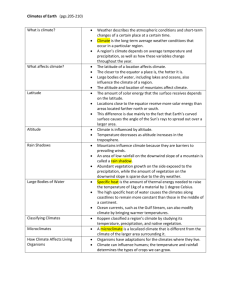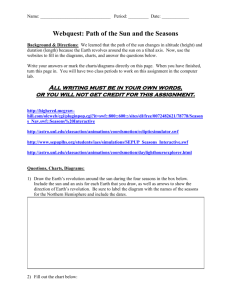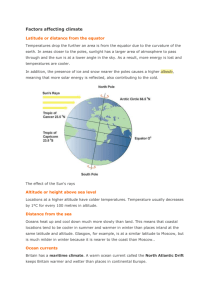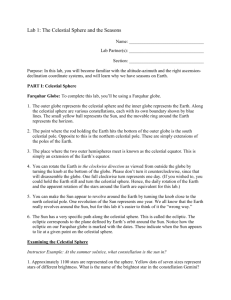Celestial Globes Lab
advertisement
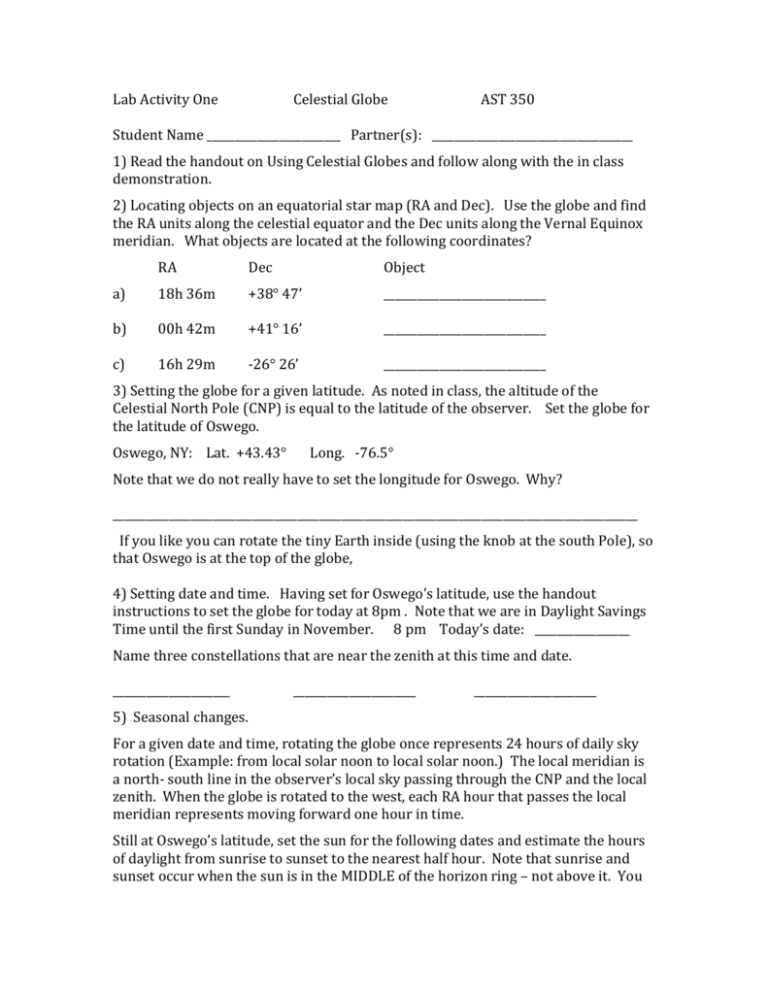
Lab Activity One Celestial Globe AST 350 Student Name ________________________ Partner(s): ____________________________________ 1) Read the handout on Using Celestial Globes and follow along with the in class demonstration. 2) Locating objects on an equatorial star map (RA and Dec). Use the globe and find the RA units along the celestial equator and the Dec units along the Vernal Equinox meridian. What objects are located at the following coordinates? RA Dec Object a) 18h 36m +38° 47’ _____________________________ b) 00h 42m +41° 16’ _____________________________ c) 16h 29m -26° 26’ _____________________________ 3) Setting the globe for a given latitude. As noted in class, the altitude of the Celestial North Pole (CNP) is equal to the latitude of the observer. Set the globe for the latitude of Oswego. Oswego, NY: Lat. +43.43° Long. -76.5° Note that we do not really have to set the longitude for Oswego. Why? ______________________________________________________________________________________________ If you like you can rotate the tiny Earth inside (using the knob at the south Pole), so that Oswego is at the top of the globe, 4) Setting date and time. Having set for Oswego’s latitude, use the handout instructions to set the globe for today at 8pm . Note that we are in Daylight Savings Time until the first Sunday in November. 8 pm Today’s date: _________________ Name three constellations that are near the zenith at this time and date. _____________________ ______________________ ______________________ 5) Seasonal changes. For a given date and time, rotating the globe once represents 24 hours of daily sky rotation (Example: from local solar noon to local solar noon.) The local meridian is a north- south line in the observer’s local sky passing through the CNP and the local zenith. When the globe is rotated to the west, each RA hour that passes the local meridian represents moving forward one hour in time. Still at Oswego’s latitude, set the sun for the following dates and estimate the hours of daylight from sunrise to sunset to the nearest half hour. Note that sunrise and sunset occur when the sun is in the MIDDLE of the horizon ring – not above it. You can use symmetry around the local meridian to count the rising hours only (sunrise to local solar noon) and double that to get total sunlight hours. Also look at the sun when it is highest in the sky for each date (also known as local solar noon.) What is the azimuth of the sun at this time? (It will be the same for all dates.) ___________________ Also determine the altitude of the sun when it is highest on these dates. a) Summer Solstice: Jun. 21 Hours of daylight: ______________ Altitude (h) of sun _________ b) Winter Solstice: Dec. 21 Hours of daylight: ______________ Altitude (h) of sun _________ c) Autumnal Equinox: Sep. 21 Hours of daylight: ______________ Altitude (h) of sun _________ What do you think the hours of daylight would be on the Vernal Equinox (spring equinox on Mar. 21)? _______________ The sun is always on the ecliptic by definition. What other great circle in the sky does the sun cross on each Equinox? ______________________ What causes the seasons on Earth? _________________________________________________ 6) Local Observer coordinate system (Horizon system) Reset the globe for Oswego on today’s date at 8pm EDT (Eastern Daylight Time, NOT Eastern Standard Time or EST). Find the altitude and azimuth of the following Stars. 8pm today Deneb (RA 20h 41m Dec +45° 17’ ) Altitude _______ Azimuth __________ Arcturus (RA 14h 16m Dec +19° 11’ ) Altitude _______ Azimuth __________ Set the globe for two hours later and repeat. 10 pm today Deneb (RA 20h 41m Dec +45° 17’ ) Altitude _______ Azimuth __________ Arcturus (RA 14h 16m Dec +19° 11’ ) Altitude _______ Azimuth __________ Why did the numbers change? _________________________________________________ 7) Extra credit: Set the globe for the latitude of the South Pole. When does the sun rise? ____________________ When does the sun set? ____________________ For how long does daylight last at the south pole? _____________________



